Fire Effect and Performance of Bridge Pylon Columns under Construction
Abstract
:1. Introduction
2. Fire Scenarios of Bridge Pylon during Construction
2.1. Fire Scenarios Assumption
2.2. Fire Scenario Simulation
2.2.1. Modeling Process and Parameters
2.2.2. Setting of Fire Sources
3. Analysis of Fire Simulation Result
3.1. HRR
3.2. Temperature and Flue Gas Distribution
3.3. Chimney Effect
3.4. Temperature Distribution
4. Thermal–Mechanical Coupling Analysis
4.1. Material Thermal Parameters
4.2. Modeling of Finite Element
5. Analysis of Thermal–Mechanical Coupling Results
5.1. Heat Transfer Analysis
5.2. Mechanical Behavior Analysis
5.2.1. Stress Field
5.2.2. Displacement Field
6. Conclusions
- In the same bridge pylon, the temperature is higher in internal fire scenarios. Additionally, internal fire conditions promote the generation of the chimney effect, and the temperature influence extends in the vertical direction.
- Along the vertical direction, a single negative exponential decline of temperature is observed in internal fires, while external fires exhibit a binomial negative exponential decline of temperature.
- The transfer of fire temperature occurs in the direction of column thickness. The column is subjected to destruction within a specific thickness range. The maximum thickness affected in this study is 200 mm, which renders the column susceptible to cracking.
- Under fire conditions, the column undergoes bending deformation in the inclined direction. The maximum deformation occurs at the top of the inclined inner side of the column. The bottom of the column experiences stress concentration points, with two stress concentration points in the SP and 1 in the MP, which are vulnerable to compression damage.
- By comparing the simulation results of models with and without considering the thermal expansion coefficient, it was observed that the thermal expansion coefficient significantly impacts the model results, leading to higher stress and deformation values. Therefore, incorporating the simulation of the thermal expansion coefficient is crucial for enhancing the safety of fire protection design.
7. Prospects
- A scaled test model will be established to delve into the fire phenomena occurring within the restricted spatial confines of the pylon columns, allowing for an in-depth analysis of the governing principles.
- By conducting simulations and manipulating the length of the pylon column, the crucial length threshold for extinguishing internal flames will be determined, thereby aiming to identify the critical value.
- Various configurations encompassing distinct positions, dimensions, and quantities of working holes will be established to investigate the fire impacts on bridge pylons featuring such apertures, thereby allowing for a comprehensive evaluation of their effects and implications.
- Fire sources with different materials and unit heat release rates are considered in bridge pylon fire simulation to obtain more conservative fire safety results.
Author Contributions
Funding
Institutional Review Board Statement
Informed Consent Statement
Data Availability Statement
Acknowledgments
Conflicts of Interest
References
- Hu, J.; Carvel, R.; Usmani, A. Bridge fires in the 21st century: A literature review. Fire Saf. J. 2021, 126, 103487. [Google Scholar] [CrossRef]
- Garlock, M.; Paya-Zaforteza, I.; Kodur, V.; Gu, L. Fire hazard in bridges: Review, assessment and repair strategies. Eng. Struct. 2012, 35, 89–98. [Google Scholar] [CrossRef]
- Alos-Moya, J.; Paya-Zaforteza, I.; Hospitaler, A.; Rinaudo, P. Valencia bridge fire tests: Experimental study of a composite bridge under fire. J. Constr. Steel Res. 2017, 138, 538–554. [Google Scholar] [CrossRef]
- Alos-Moya, J.; Paya-Zaforteza, I.; Hospitaler, A.; Loma-Ossorio, E. Valencia bridge fire tests: Validation of simplified and advanced numerical approaches to model bridge fire scenarios. Adv. Eng. Softw. 2019, 128, 55–68. [Google Scholar] [CrossRef]
- Aziz, E.M.; Kodur, V.K.; Glassman, J.D.; Garlock, M.E.M. Behavior of steel bridge girders under fire conditions. J. Constr. Steel Res. 2015, 106, 11–22. [Google Scholar] [CrossRef]
- Mahamid, M.; Taghipour Anvari, A.; Torra-Bilal, I.; Brindley, T.; McNallan, M. Comparison of fire resistance of damaged fireproofed steel beams under hydrocarbon pool fire and ASTM E119 fire exposure. J. Struct. Fire Eng. 2019, 10, 193–232. [Google Scholar] [CrossRef]
- An, W.; Shi, L.; Wang, H.; Zhang, T. Study on the effect of bridge deck spacing on characteristics of smoke temperature field in a bridge fire. Fire 2022, 5, 114. [Google Scholar] [CrossRef]
- Kodur, V.K.R.; Naser, M.Z. Designing steel bridges for fire safety. J. Constr. Steel Res. 2019, 156, 46–53. [Google Scholar] [CrossRef]
- Kodur, V.; Gil, A. Fire hazard in concrete bridges: Review, assessment and mitigation strategies. Struct. Infrastruct. Eng. 2022, 1–18. [Google Scholar] [CrossRef]
- Kodur, V.; Kumar, P.; Rafi, M.M. Fire hazard in buildings: Review, assessment and strategies for improving fire safety. PSU Res Rev. 2020, 4, 1–23. [Google Scholar] [CrossRef]
- Liu, M.Y.; Tian, W.; Wang, Y.; Jing, W. Numerical simulation of ultimate of slings for three-tower and four-span suspension bridge under tanker fire. Appl. Mech. Mater. 2013, 361, 1187–1193. [Google Scholar] [CrossRef]
- Liu, M.Y.; Tian, W.; Wang, Y.; Jing, W.; Chen, X. Risk prevention measures for three-tower and four-span suspension bridge under vehicle fire. Adv. Mater. Res. 2014, 919, 590–597. [Google Scholar] [CrossRef]
- Nariman, N.A. Thermal fluid-structure interaction and coupled thermal-stress analysis in a cable stayed bridge exposed to fire. Front. Struct. Civ. Eng. 2018, 12, 609–628. [Google Scholar] [CrossRef]
- Zhang, Y.; Fang, Z.; Jiang, R.; Xiang, Y.; Long, H.; Lu, J. Static performance of a long-span concrete cable-stayed bridge subjected to multiple-cable loss during construction. J. Bridge Eng. 2020, 25, 04020002. [Google Scholar] [CrossRef]
- Liu, Z.; Silva, J.C.G.; Huang, Q.; Hasemi, Y.; Huang, Y.; Guo, Z. Coupled CFD–FEM simulation methodology for fire-exposed bridges. J. Bridge Eng. 2021, 26, 04021074. [Google Scholar] [CrossRef]
- Xu, C.; Liu, Z. Coupled CFD-FEM Simulation of Steel Box Bridge Exposed to Fire. Adv. Civ. Eng. 2022, 2022, 5889743. [Google Scholar] [CrossRef]
- Cui, C.; Chen, A.; Ma, R. Stability assessment of a suspension bridge considering the tanker fire nearby steel-pylon. J. Constr. Steel Res. 2020, 172, 106186. [Google Scholar] [CrossRef]
- Rujin, M.A.; Chuanjie, G.U.I.; Minglei, M.A. Structural performance analysis of a three-pylons suspension bridge considering fire accident in the vicinity of middle steel pylon. J. Hunan Univ. 2017, 44, 88–95. [Google Scholar] [CrossRef]
- Hosseini, O.; Maghrebi, M. Risk of fire emergency evacuation in complex construction sites: Integration of 4D-BIM, social force modeling, and fire quantitative risk assessment. Adv. Eng. Inform. 2021, 50, 101378. [Google Scholar] [CrossRef]
- Das, S. Review of risk factors of construction site fire and suggestions for its mitigation. Asian Rev. Civ. Eng. 2013, 2, 13–19. [Google Scholar] [CrossRef]
- Sivakumar, C.; Malathy, R.; Sivaprakash, P. A study on fire safety on residential and commercial construction sites. Arch. Civ. Mech. Eng. 2018, 64, 161–174. [Google Scholar] [CrossRef]
- Mensah, R.A.; Jiang, L.; Renner, J.S.; Xu, Q. Characterisation of the fire behaviour of wood: From pyrolysis to fire retardant mechanisms. J. Therm. Anal. Calorim. 2022, 148, 1407–1422. [Google Scholar] [CrossRef] [PubMed]
- Stec, A.A.; Hull, T.R. Assessment of the fire toxicity of building insulation materials. Energy Build. 2011, 43, 498–506. [Google Scholar] [CrossRef]
- Bilotta, A.; de Silva, D.; Nigro, E. Tests on intumescent paints for fire protection of existing steel structures. Constr. Build Mater. 2016, 121, 410–422. [Google Scholar] [CrossRef]
- Sun, X.Q.; Luo, M.C. Fire risk assessment for super high-rise buildings. Procedia Eng. 2014, 71, 492–501. [Google Scholar] [CrossRef]
- Shin, Y.J.; You, W.J. Effects of welding time and electrical power on thermal characteristics of welding spatter for fire risk analysis. Energies 2020, 13, 6502. [Google Scholar] [CrossRef]
- Gernay, T. Fire resistance and burnout resistance of reinforced concrete columns. Fire Saf. J. 2019, 104, 67–78. [Google Scholar] [CrossRef]
- Han, L.H.; Zhou, K.; Tan, Q.H.; Song, T.Y. Performance of steel reinforced concrete columns after exposure to fire: Numerical analysis and application. Eng. Struct. 2020, 211, 110421. [Google Scholar] [CrossRef]
- Wang, J.H.; He, J.; Xiao, Y. Fire behavior and performance of concrete-filled steel tubular columns: Review and discussion. J. Constr. Steel Res. 2019, 157, 19–31. [Google Scholar] [CrossRef]
- Van Coile, R.; Hopkin, D.; Elhami-Khorasani, N.; Gernay, T. Demonstrating adequate safety for a concrete column exposed to fire, using probabilistic methods. Fire Mater. 2021, 45, 918–928. [Google Scholar] [CrossRef]
- Kim, H.J.; Lilley, D.G. Heat release rates of burning items in fires. J. Propuls. Power 2002, 18, 866–870. [Google Scholar] [CrossRef]
- Ezinwa, J.U.; Robson, L.D.; Obach, M.R.; Torvi, D.A.; Weckman, E.J. Evaluating models for predicting full-scale fire behaviour of polyurethane foam using cone calorimeter data. Fire Technol. 2014, 50, 693–719. [Google Scholar] [CrossRef]
- Zeng, Z.; Xiong, K.; Lu, X.L.; Weng, M.C.; Liu, F. Study on the smoke stratification length under longitudinal ventilation in tunnel fires. Int. J. Therm. Sci. 2018, 132, 285–295. [Google Scholar] [CrossRef]
- Lan, B.; Li, Y.R.; Li, P.C.; Gong, H.F. Numerical simulation of the chimney effect on smoke spread behavior in subway station fires. Case Stud. Therm. Eng. 2022, 39, 102446. [Google Scholar] [CrossRef]
- Song, Z.; Huang, X.; Kuenzer, C.; Zhu, H.; Jiang, J.; Pan, X.; Zhong, X. Chimney effect induced by smoldering fire in a U-shaped porous channel: A governing mechanism of the persistent underground coal fires. Process. Saf. Environ. 2020, 136, 136–147. [Google Scholar] [CrossRef]
- Wang, H.; Mang, H.; Yuan, Y.; Pichler, B.L. Multiscale thermoelastic analysis of the thermal expansion coefficient and of microscopic thermal stresses of mature concrete. Materials 2019, 12, 2689. [Google Scholar] [CrossRef]

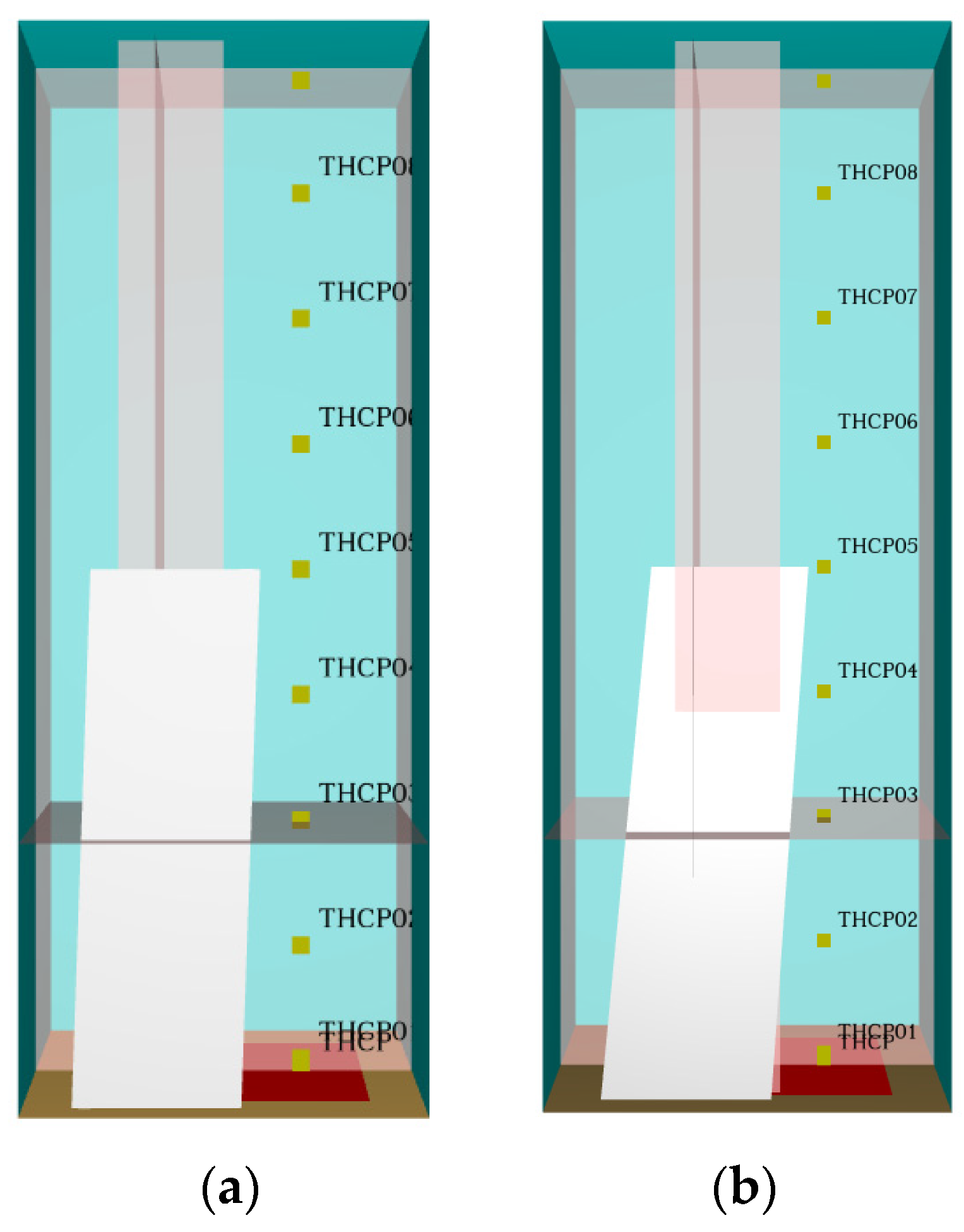
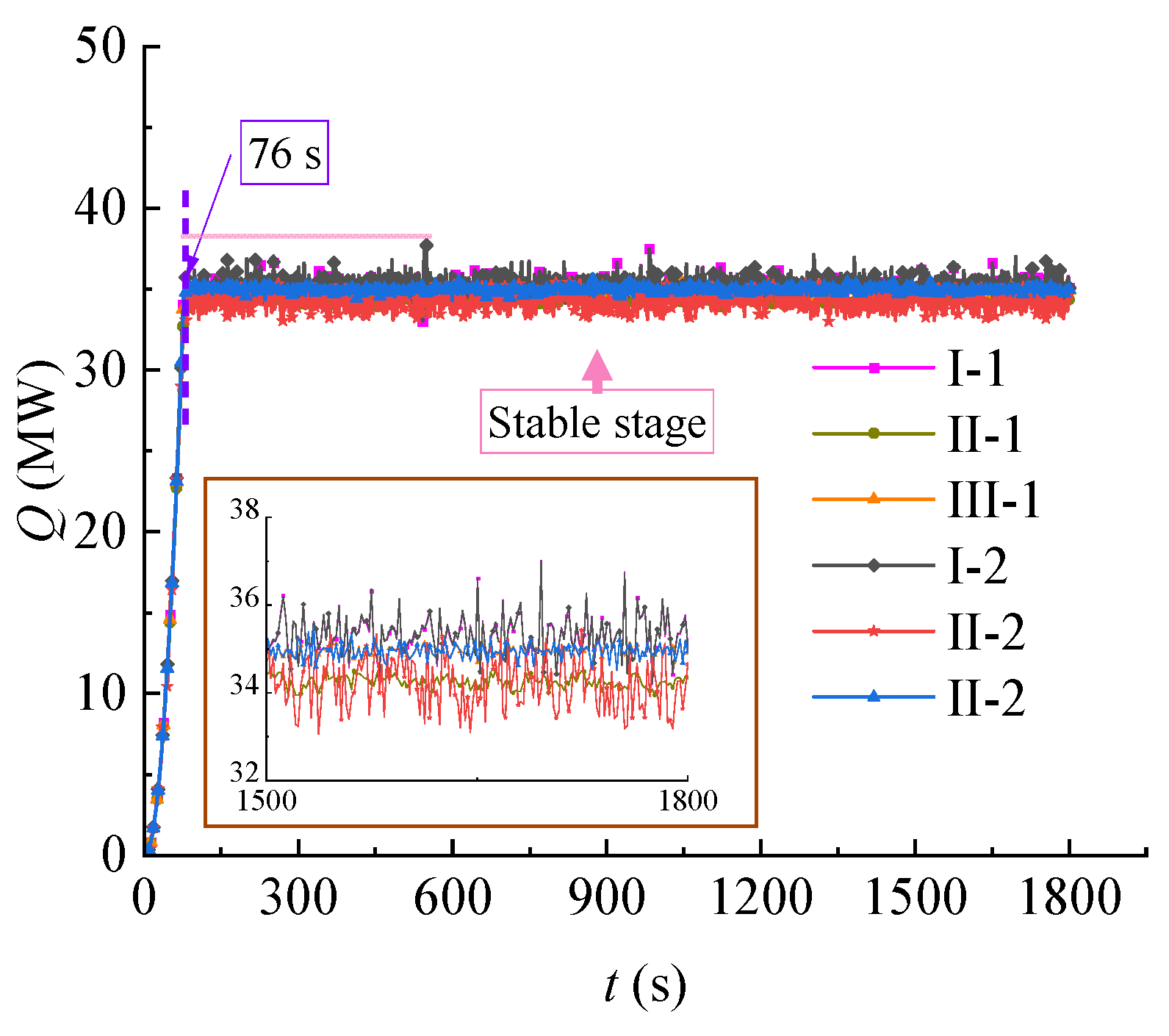


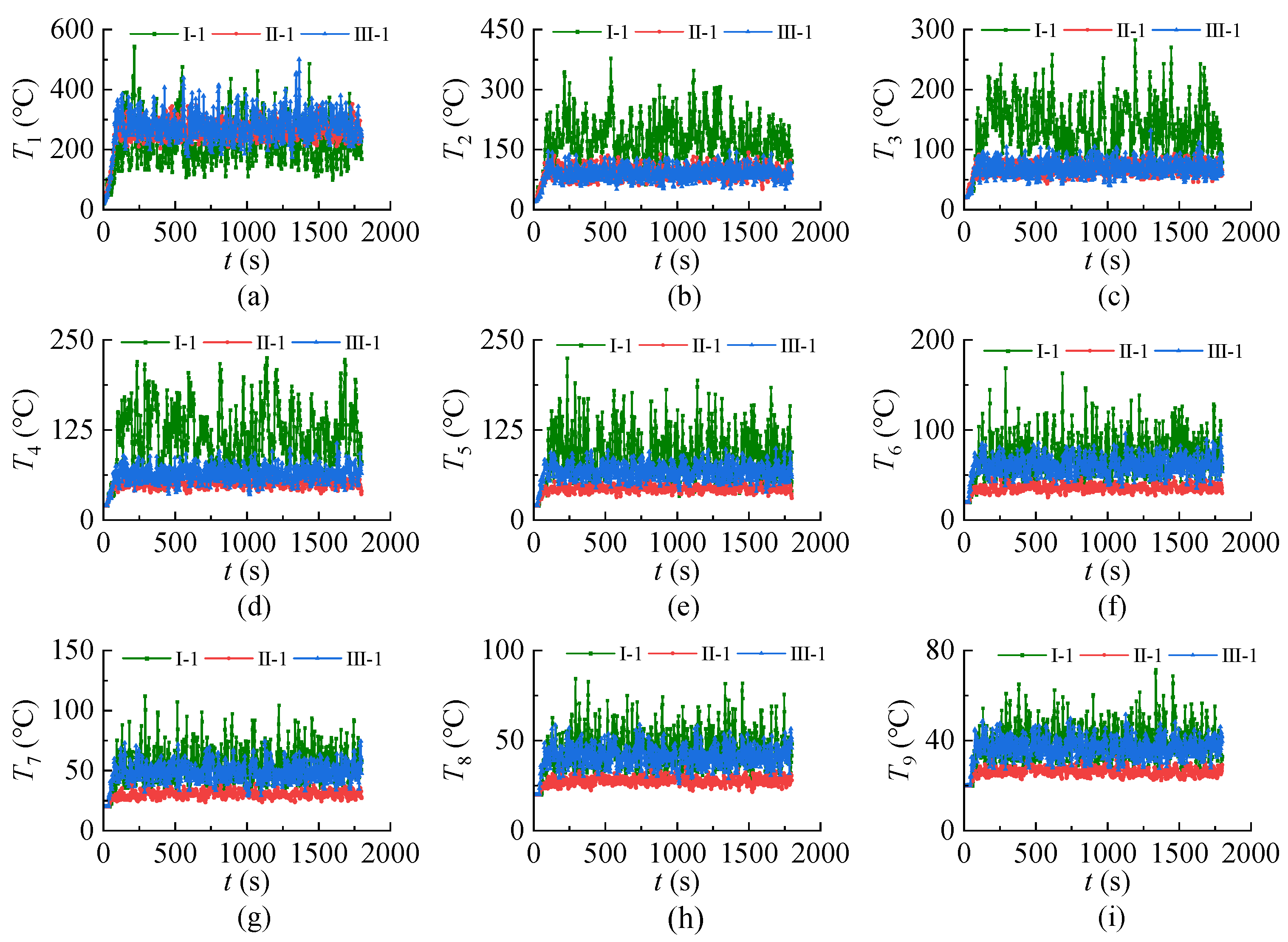
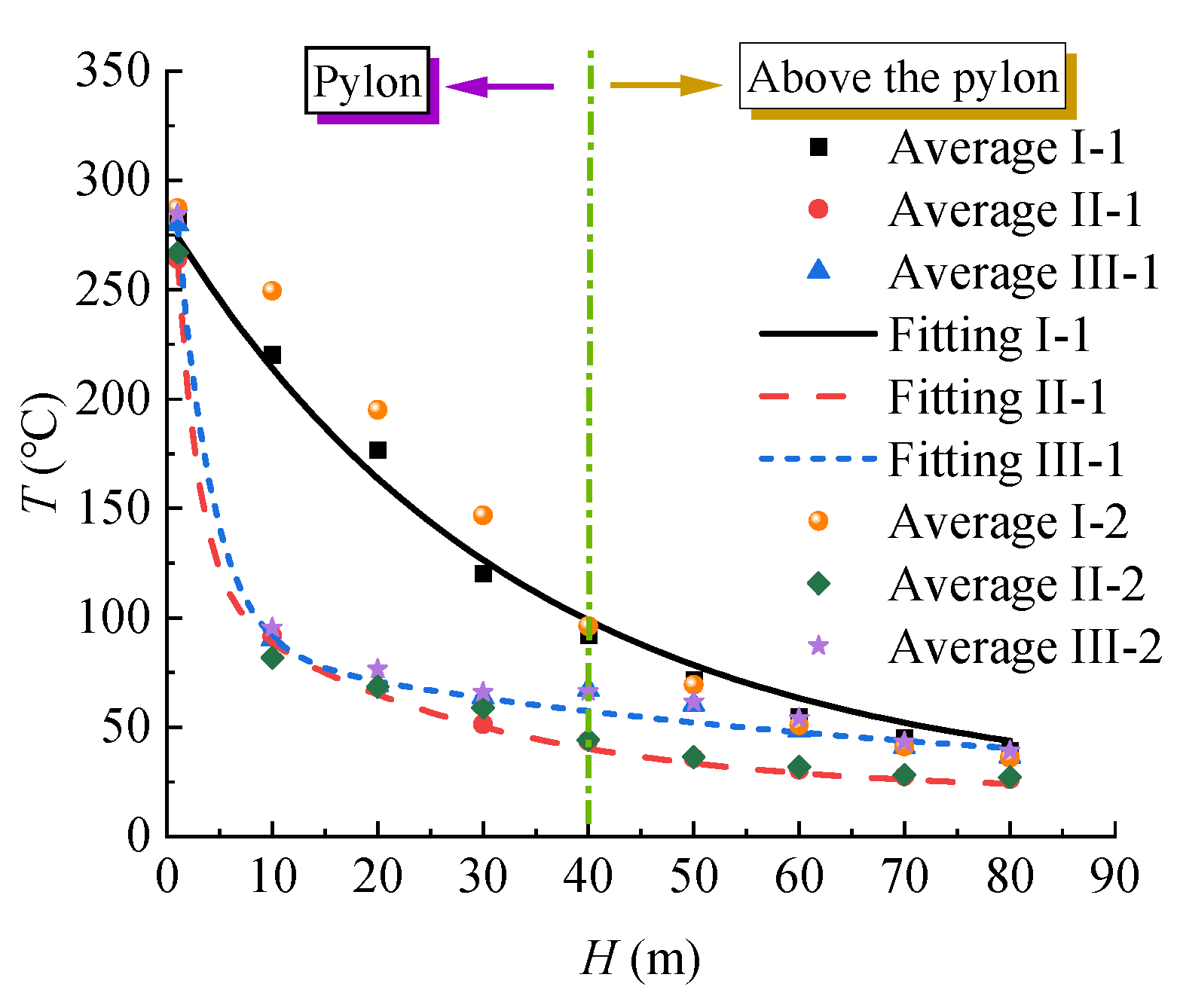
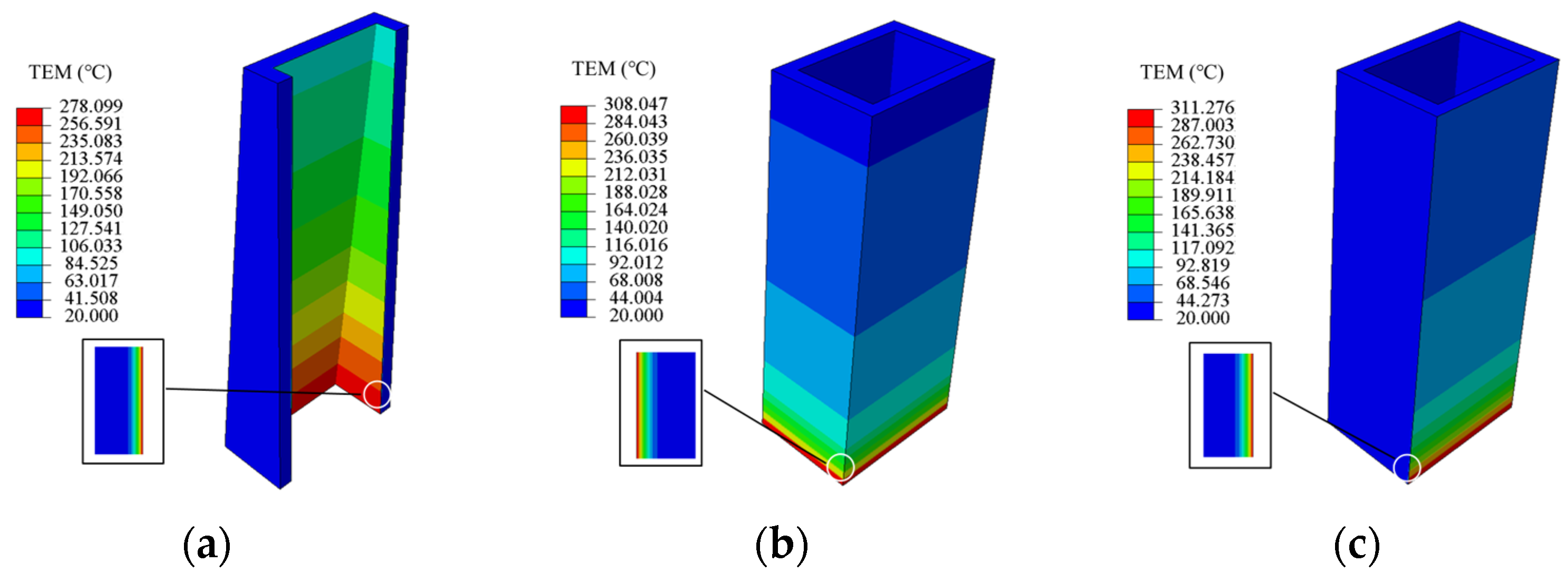
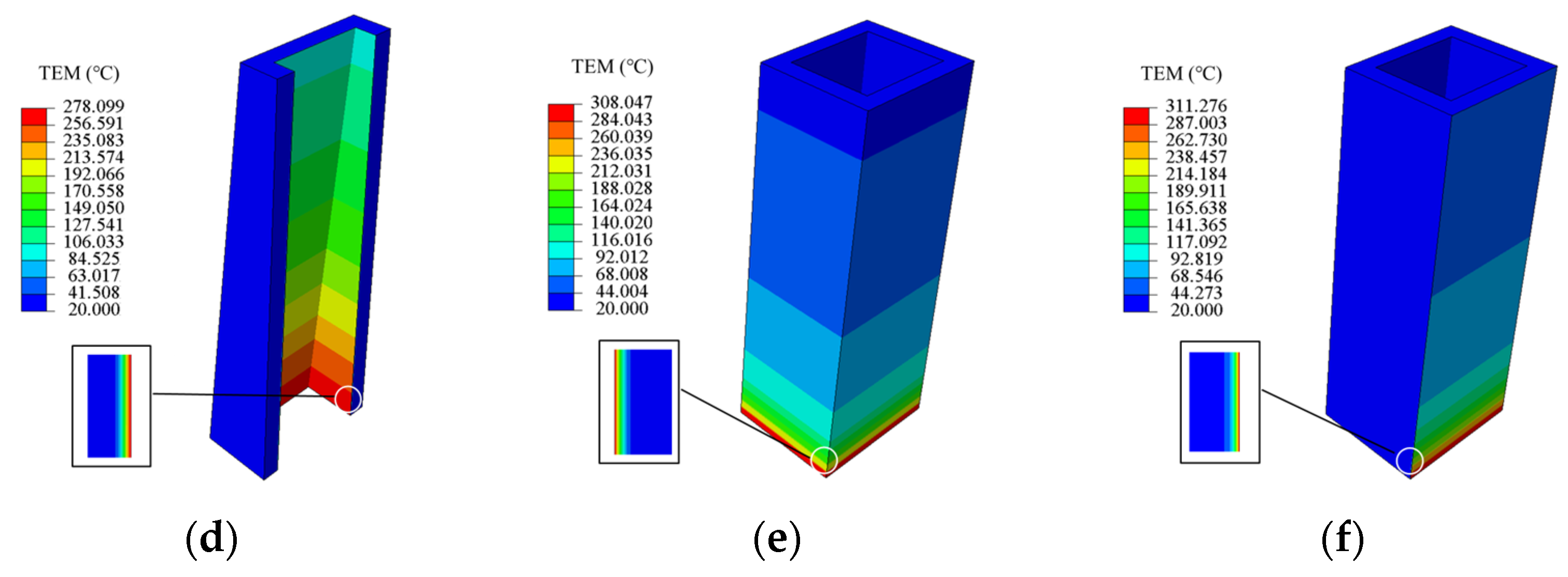
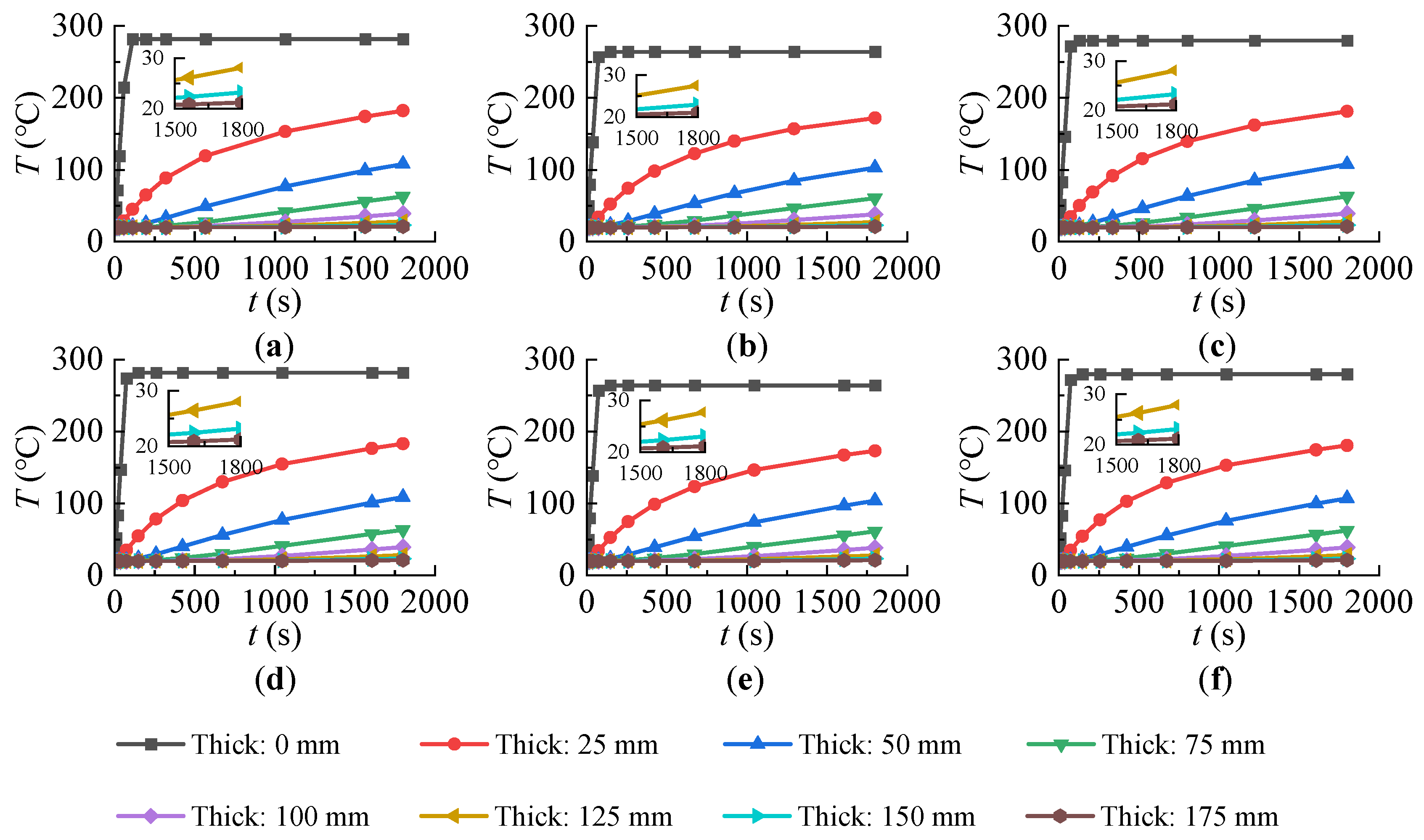
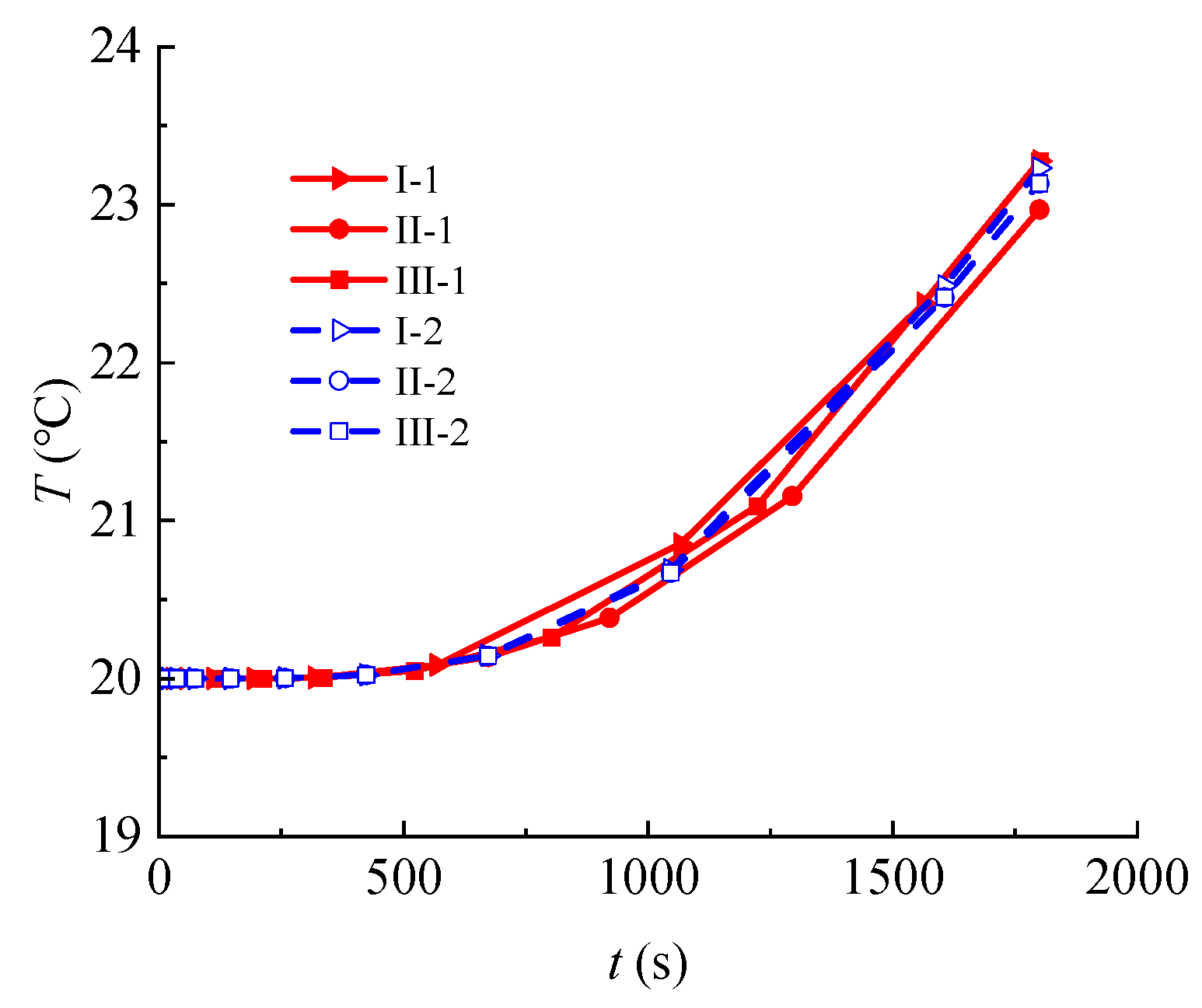
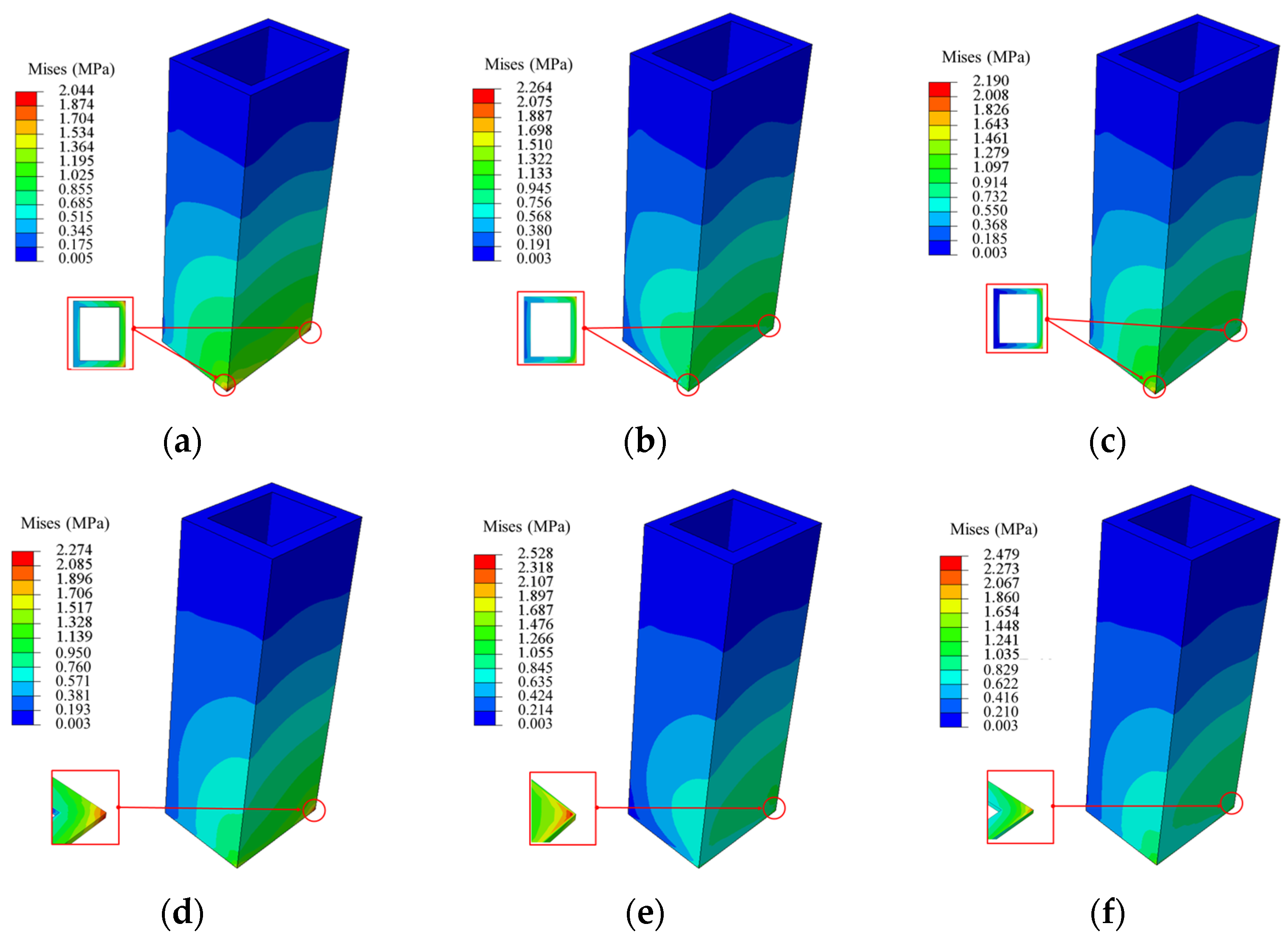
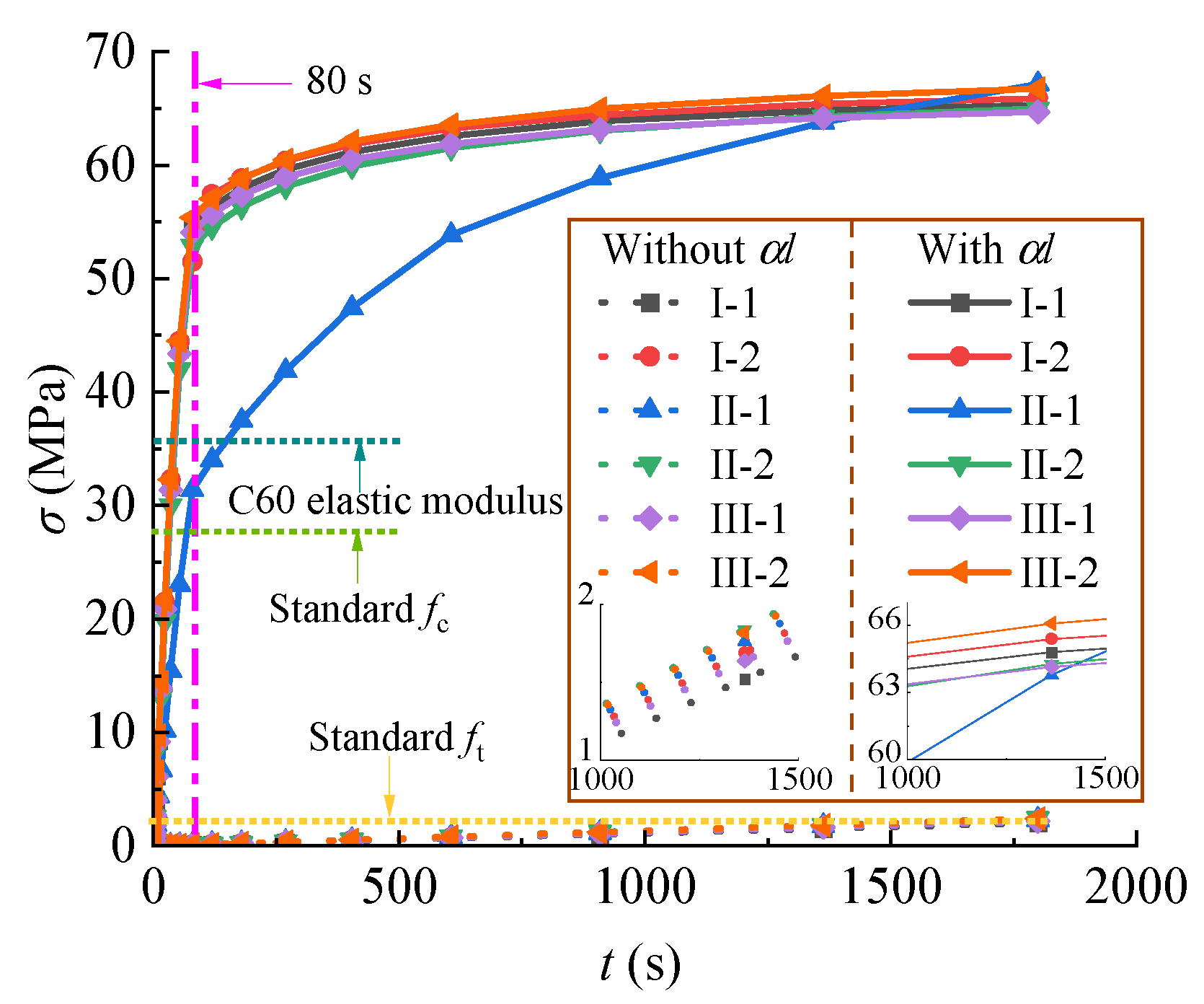

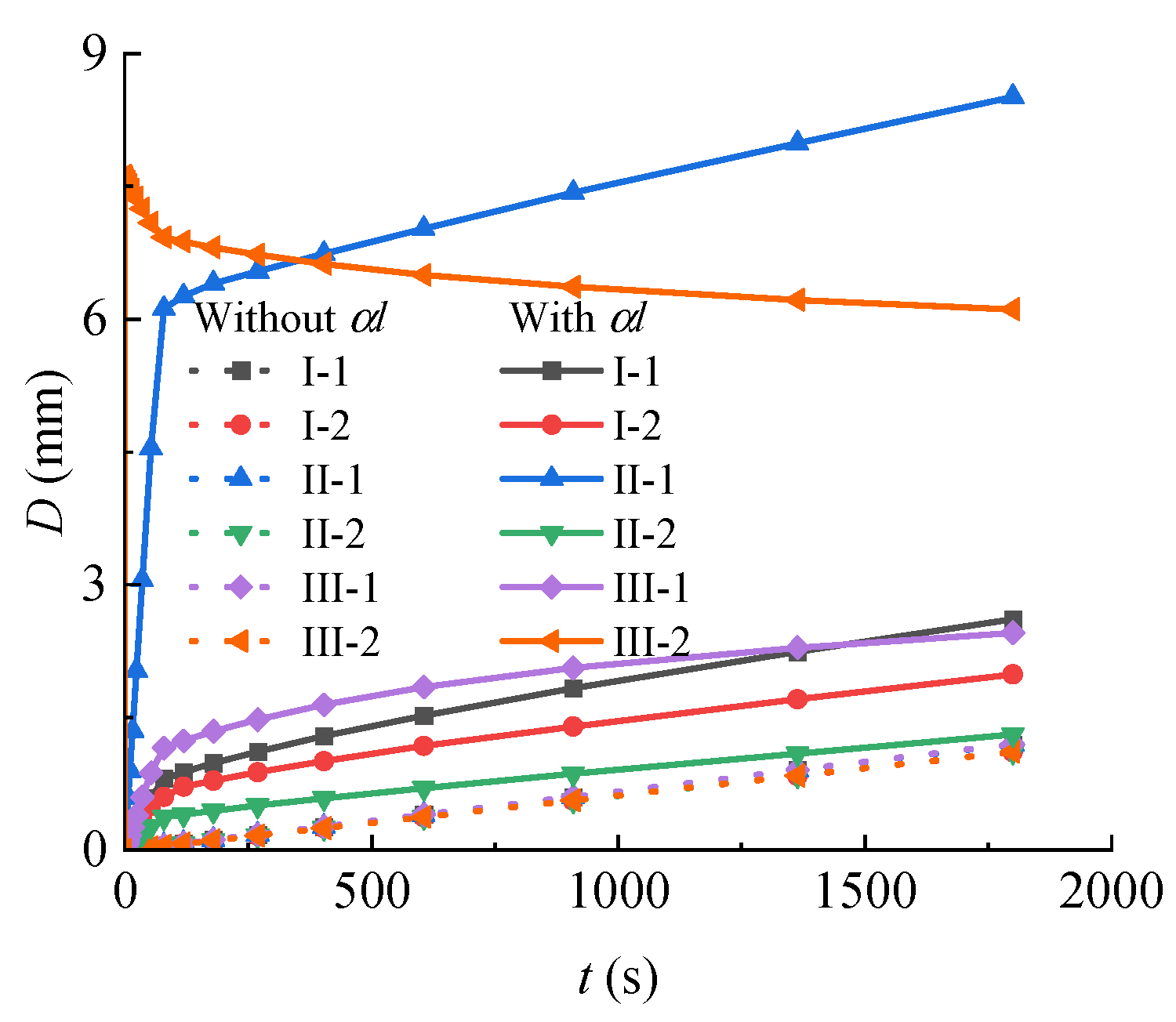
| Scenario | Types of Scenarios | Location of Fire Source | |
|---|---|---|---|
| I | 1 | Internal fire of SP |  |
| 2 | Internal fire of MP | ||
| II | 1 | External ring fire of SP |  |
| 2 | External ring fire of MP | ||
| III | 1 | External fire on one side of SP |  |
| 2 | External fire on one side of MP | ||
| Scenario | Number |
|---|---|
| I-1 | 248,460 |
| I-2 | 256,000 |
| II-1 | 246,000 |
| II-2 | 256,000 |
| III-1 | 89,800 |
| III-2 | 88,700 |
Disclaimer/Publisher’s Note: The statements, opinions and data contained in all publications are solely those of the individual author(s) and contributor(s) and not of MDPI and/or the editor(s). MDPI and/or the editor(s) disclaim responsibility for any injury to people or property resulting from any ideas, methods, instructions or products referred to in the content. |
© 2023 by the authors. Licensee MDPI, Basel, Switzerland. This article is an open access article distributed under the terms and conditions of the Creative Commons Attribution (CC BY) license (https://creativecommons.org/licenses/by/4.0/).
Share and Cite
Li, Y.; Wang, Z.; Wang, C.; Zhang, Y.; Ma, H.; Liu, L. Fire Effect and Performance of Bridge Pylon Columns under Construction. Fire 2023, 6, 387. https://doi.org/10.3390/fire6100387
Li Y, Wang Z, Wang C, Zhang Y, Ma H, Liu L. Fire Effect and Performance of Bridge Pylon Columns under Construction. Fire. 2023; 6(10):387. https://doi.org/10.3390/fire6100387
Chicago/Turabian StyleLi, Yang, Zuocai Wang, Changjian Wang, Yin Zhang, Hongsheng Ma, and Lili Liu. 2023. "Fire Effect and Performance of Bridge Pylon Columns under Construction" Fire 6, no. 10: 387. https://doi.org/10.3390/fire6100387
APA StyleLi, Y., Wang, Z., Wang, C., Zhang, Y., Ma, H., & Liu, L. (2023). Fire Effect and Performance of Bridge Pylon Columns under Construction. Fire, 6(10), 387. https://doi.org/10.3390/fire6100387





